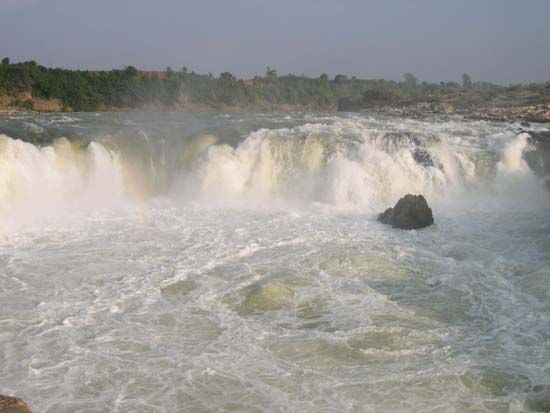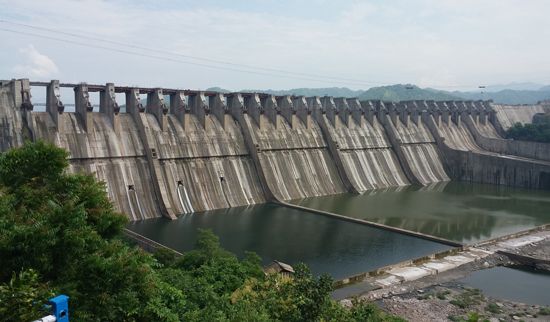


The Narmada River is one of the most important waterways in central India. It flows to the west through the states of Madhya Pradesh, Gujarat, and Maharashtra to the Arabian Sea (through the Gulf of Khambhat). The river is 815 miles (1,312 kilometers) long, and it gets water from 41 smaller rivers, called tributaries. The Narmada drainage basin (an area of land from which all rain or snow flows to the same body of water, such as a river) is 38,145 square miles (98,796 square kilometers). The Narmada River is sometimes called the Narbada or Nerbudda.

The Narmada River begins in the Maikala Range at an elevation of about 3,500 feet (1,080 meters). After flowing through the hills near Mandla in eastern Madhya Pradesh, the river passes through valleys between the Vindhya and Satpura mountain ranges. It then goes through various regions, including plains, hills, and gorges. The Narmada has many waterfalls, including Dhuandhar Falls to the southwest of Jabalpur, one of the most populous cities in Madhya Pradesh. The river’s tributaries sometimes cause flooding in the valley areas. In addition to Jabalpur, important cities and towns along the Narmada include Hoshangabad, Maheshwar, Handia, and Mandhata.
The Narmada River supports many different species of animals and plants. It is home to various fish, and crocodiles can be found in some areas. Many different species of birds inhabit the area. The forests near the river include such animals as deer, tigers, and leopards. Threats to the Narmada River area include pollution and the loss of forest land because of agricultural and urban development.
The source of the Narmada River is the Narmada Kund (kund means “reservoir” or “small lake”). The Narmada Kund is located in the town of Amarkantak, in Madhya Pradesh state. The Narmada Kund is considered a holy site in Hinduism. According to Hindu beliefs, the Narmada River sprang from the body of the god Shiva. Many Hindus visit the river as part of a pilgrimage.

The Narmada River is an important source of water for many areas. It’s used to generate hydroelectricity and to irrigate agricultural lands. There are several dams along the river. Major hydroelectric projects include the Indira Sagar Dam, the Omkareshwar Dam, the Bargi Dam, and the Maheshwar Dam. One of the largest projects, the Sardar Sarovar Dam in Gujarat state, had been planned since the 1960s and was finally completed in 2017. However, the construction sparked controversy. For example, in 1985 a protest movement called the Narmada Bachao Andolan arose. It drew attention to the plight of local people who were going to be displaced by the dam.
Since the 1960s, several Indian states have disagreed over how to use the Narmada River’s water. In 1969 a court was established to settle disputes. Since 1980 the Narmada Control Authority (NCA) has been in charge of carrying out the court’s orders. The NCA includes representatives of the union (central) government and the states of Madhya Pradesh, Gujarat, Maharashtra, and Rajasthan.

